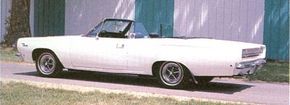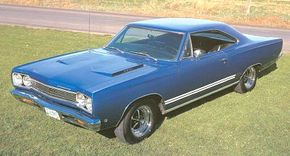It's amazing what steady cultivating can do. In 1962, Plymouth's crop of downsized "standard" cars was like unwanted surplus. Yet with a few interim changes, their descendants of six years -- the 1968-1969 Plymouth Sport Satellite and GTX -- later sold more than a quarter-million copies.
Progressively nicer styling helped, but a more important factor was the 1965 return of a true full-size Plymouth, the 119-inch-wheelbase Fury. This allowed the existing 116-inch models (wagons: 117) to compete exclusively in the mid-size field, which they successfully did as workaday Belvedere I and II models and a bucket-seat twosome called Satellite.
Advertisement
For 1966, Plymouth lit every street racer's fire by making the famed 426-cid Hemi V-8 a regular production option for its mid-size cars, thus increasing their dominance of the nation's quarter-mile action.
The following year, this iron fist was wrapped in a velvet glove called Belvedere GTX, a lush buckets-and-console convertible and hardtop coupe packing a standard 375-horsepower wedgehead 440. All that remained was to fix styling that was looking literally and figuratively square against the latest from GM and Ford.
Chrysler did just that for 1968 with a fully redesigned B-body for Belvedere/ Satellite/GTX and Dodge's Coronet/Charger. Plymouth greatly expanded offerings into what it called "The Mid-Size 5."
A stripped Belvedere pillared coupe, four-door sedan, and wagon started things off, then repeated with a two-door hardtop and convertible as a "family" Satellite series (replacing Belvedere II).
Next up were a new Sport Satellite convertible, hardtop coupe, and four-door wagon with still-better trim, though not necessarily the best performance. That was reserved for the potent GTX duo and a new no-frills muscle coupe, the whimsically named Road Runner, which is a story in itself.
All 1968 Plymouth intermediates wore smoother, more rounded styling with modestly humped rear fenders, simple grilles, subtle bodyside creases, more radically tucked rockers, and broad rear decks with wedgy taillamps.
Unfortunately, even this slicker B-body proved to be less aerodynamic than the new ultra-smooth 1968 Ford Torino/Mercury Cyclone fastbacks, which ran faster around stock-car supertracks and into the Winner's Circle more often. But MoPar still ruled the drags, with the likes of Ronnie Sox and Buddy Martin adding to Chrysler's vast collection of Super Stock trophies.
Find engine details and more on the 1968-1969 Plymouth Sport Satellite and GTX on the next page.
For more information on cars, see:
- Classic Cars
- Muscle Cars
- Sports Cars
- Consumer Guide New Car Search
- Consumer Guide Used Car Search
Advertisement



